By: Nancy Stratman, NDA Archivist
To help celebrate the 60th anniversary of the move to the Hilton campus, the publications class was asked to think about the many “traditions” that are celebrated at NDA. Obvious ones came to their minds quickly: the gray skirt, the “wigalo” cheer, senior car painting, Halloween costume contest, “bucca” chicken for lunch, etc. But, as most “traditions” go, these experiences are time sensitive; celebrated events that can truly only be remembered through familiarity, not actually handed down through the ages. Perhaps unbeknownst to most current students, the history of NDA overflows with time-honored traditions that have been celebrated every decade since our founding and have been enjoyed by every generation of students that have entered the doors of NDA, be it on Fifth Street or Hilton Drive. These traditions have helped to create the template of the modern NDA student. A study into these events help to provide the meaning behind and the importance of continuing these true traditions of NDA’s heritage.
In the Spring, 2024 edition the Notre Damian we looked at the oldest NDA tradition- that of honoring the Virgin Mary. In this edition we will explore another one of the oldest traditions celebrated at Notre Dame Academy – the formal celebration of commencement exercises, commonly known as graduation.
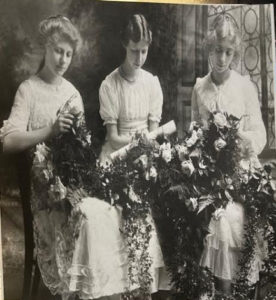
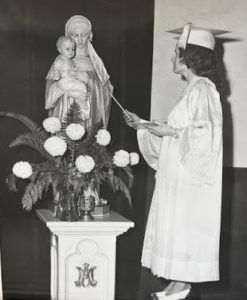
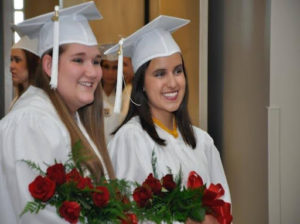
(1915) (1950) (2012)
In September of 1876, Notre Dame Academy officially welcomed their first students on the 5th Street campus. Classes were initiated for kindergarten and the first six elementary grades. There were 10 members on faculty and a total of 60 students (both girls and boys) enrolled. By the turn of the century, NDA had expanded both its number of students, and the type of educational programs that were offered. All students could now take a general curriculum of classes up through the junior high level, usually considered 9th grade. NDA also offered a two-year commercial program for young women who desired to obtain the educational background to enter the work force full-time by the age of 14 or 15. Soon afterwards, it was decided to expand the academic offerings to encompass a full four-year high school curriculum for girls only.
Prior to the establishment of the high school, NDA celebrated the end of the school year with a program of music, dance and recitations to showcase the talents of its student body. At the end of the program, certificates of achievement and awards for proficiency were given out to those students who had reached the end of their educational experience at NDA. These celebratory showcases continued until the close of the grammar school in June of 1937.
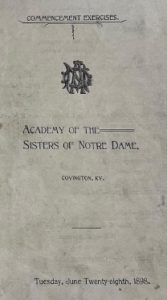 .
. 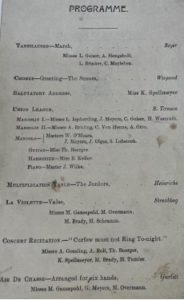 .
. 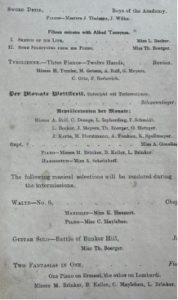 .
. 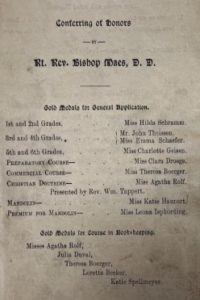
(Commencement Program from 1898)
By August 1906, NDA was ready to implement a fully developed advanced program for girls beyond the 8th grade. By May of 1907, the Notre Dame Academy High School Commercial Studies Program was ready to graduate 4 students who had completed the requirements for the two-year programs: Matilda Wilke, Appolonia Smith, Mary Lubrecht and Mary Von Handorf*. Three years later, in May of 1910, Marie Hermes was the first scientific class graduate*. (*based on hand-written records)

During these early years, the commencement program remained similar to those of the past, incorporating musical selections by grade level, prose and dramatic readings, as well as a showcase of individual and group talents including song, dance and instrumental. At the conclusion of the program, medals of accomplishments for the elementary grades, and diplomas for graduates of the 8th grade, commercial, and scientific courses were blessed and presented to each graduate.
By 1912, enrollment in the high school program had grown to the point that the commencement program was split into the more traditional end of the year celebrations for the grade school (girls and boys K-7) and a more formal graduation program for the high school, including the 8the grade girls. These ceremonies then became the prototype for our modern commencement program.
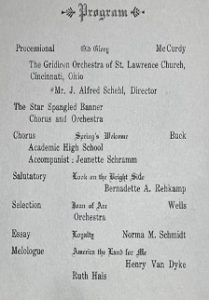
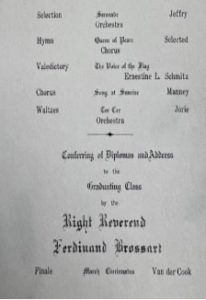
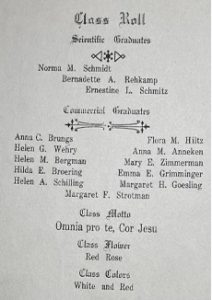
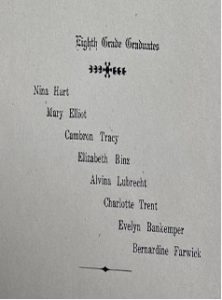 (Commencement program from 1918)
(Commencement program from 1918)
A typical commencement program from 1918 well into the early 1930s included musical and choral selections performed by the school orchestra (or invited guest ensembles) and the school chorus and a reading of the prize-winning oratory. “There was an annual oratorical contest held in May. Topics from which to choose included “The Value of a Catholic Education”, “Economy as the Basis of Good Citizenship”, “Use of Leisure Time”, Is Man a Machine”, and “What Does the World Expect of the US; What do We to Expect of the World?”. According to tradition, each senior is required to write an oration of 1,000 words on one of the required subjects and to present it from memory to an audience composed of the faculty and the high school. The winner of the oratorial contest will deliver her address on the night of commencement.” (The Gavel, 1936)
The ceremony was held in the evening at Mother of God auditorium and was attended by the entire school and parents of the graduates. Freshmen and sophomores, wearing their school uniforms, led the procession from the academy to the auditorium which was across the street. Once all were seated, the junior class entered, acting as an honor guard for the seniors who followed. Often younger sisters of the graduates, carrying baskets of flowers, lined the aisles as the graduates entered the auditorium.

(1920 graduates and their little sisters)
Three seniors were awarded the privilege of addressing the graduates during the program: the first, delivering a Salutatory address to welcome the graduates and provide a remembrance of their years at the school; the second, presenting her winning essay from the annual Oratory contest; and the third, delivering a Valedictory address to conclude the ceremony and motivate the new graduates to continue to live by the norms and knowledge they received at Notre Dame Academy. In preparation for the distribution of diplomas, the seniors stood as a class and sang a hymn dedicated to the Virgin Mary, followed by a presentation of awards for individual achievement and scholarships for further study were announced. And then, at long last, came the moment that every student had been waiting for, the distribution of diplomas. From the records available, it appears that the 8th grade students were called first, then the graduates from the Commercial Program, followed by the graduates from the Scientific Program. Each graduate was presented with her diploma and a souvenir program listing the names of each graduate, their class patron, class motto, class flower and class colors. At the conclusion of the program, each graduate stood shoulder to shoulder and recited the “Prayer for a Girl Graduate” a poem entreating the Blessed Virgin to guide them as they left the halls of Notre Dame and ventured forth into the world.
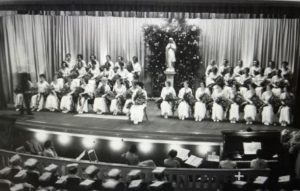
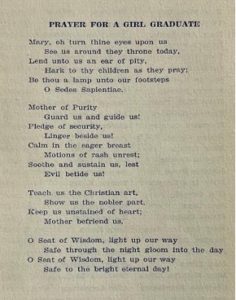
(Commencement, 1930)
In the early 1930s, the number of total scientific program graduates had grown so large that the commencement ceremonies had to be divided into two events, one for the commercial graduates and one for the scientific graduates. The two ceremonies were held on successive evenings. The actual ceremonies were identical with the entire student body taking part, the juniors leading in the graduates and the graduates wearing their white dresses and carrying rose bouquets. By the start of the 1933-34 academic year, the number of commercial students had dwindled to the point that the program was no longer viable. The last commercial division graduation was held in June of 1934.
The move to the new campus in October of 1963 marked the end of some of the traditional rituals celebrated by NDA seniors: the inclusion of all students attending, the escort of seniors by the entire junior class and the actual ceremony at Mother of God Church. The 1964 commencement ceremonies were the last to be held at Mother of God Church in Covington. Beginning in June of 1965, commencement ceremonies moved to the Cathedral and were only attended by the graduates, their parents and selected juniors who acted as an honor guard.
Between 1965 and 1970, the events of graduation day were changed to start with a Mass at either St. Agnes or in the NDA auditorium for the graduates and their parents, followed by a breakfast at the Academy and then the actual commencement ceremonies held that evening at a variety of suburban churches, including St. Agnes, St. Therese and St. Catherine.
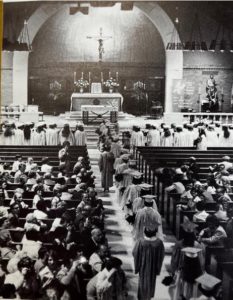
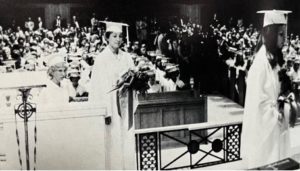
In 1971, the celebratory Mass and the commencement ceremony were combined into one event in the evening. The evening events were attended by just selected members of the junior class, who acted as a senior honor guard, the graduates and their parents. By 1974, this program became the standard for Notre Dame commencements and was usually held at St. Agnes Church.
But, in December of 1987, Bishop Hughes decreed that no longer would he allow graduation Masses to be celebrated as part of the actual commencement ceremonies, because he felt that the inclusion of the commencement ceremony diminished the importance of the Mass. Thus, the senior class of 1988, returned to the older tradition of simply celebrating their commencement ceremony as one event, with the Mass and breakfast held separately.
During the early 2000s, in order to accommodate more guests, the location for the actual commencement ceremony was moved to the NKY Convention Center.

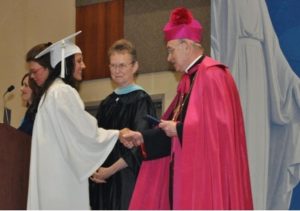
Between the late 1960s and 2000, seniors took the opportunity to express their individualism as well as their cohesiveness as a class during the celebratory graduation Mass and commencement ceremony in a less traditional way. Banners decorated with the senior class theme were carried into Mass and displayed at commencement. These themes were usually centered on uplifting messages focused on the future and their place in the world, such as “Today is the tomorrow we dreamed of yesterday”, “Friends are friends forever” and “If you can imagine it, you can achieve it; if you can dream it, you can become it.”
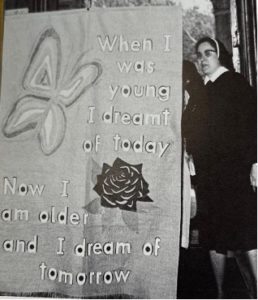
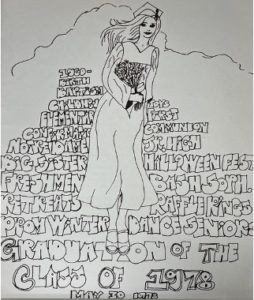
(Class banner and Graduation Program covers from the 1970s)
Music for the graduation Mass also changed to reflect a more modern atmosphere. During this era the Mass seemed to reflect a less traditionally solemn atmosphere with the music that was offered. Selections often included more current songs from popular musicals such as Sabbath Prayer from Fiddler on the Roof, All Good Gifts from Jesus Christ Superstar and You’ll Never Walk Alone from Carousel and from popular entertainers such We’ve Only Just Begun by The Carpenters and You’ve Got A Friend in Me by Randy Newman.
Music for the commencement ceremonies during the early to mid- 1960s, was usually based on traditional hymns and always included the school song and a song dedicated to Mary as the closing hymn. From the 1970s until 2010 musical selections for each commencement included more current, secular songs. During many of these ceremonies, after the welcome and a scripture reading, the graduates would turn and sing a song directed to their parents. These included selections such as “Because You Loved Me”, “Wind Beneath My Wings”, and “You’ll Be in My Heart”.
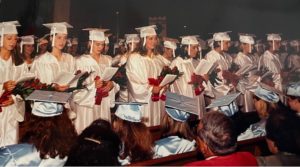
(parent song, Graduation, 1997)
Most of these commencement ceremonies would include a blessing and words of wisdom from the Provincial from the Sisters of Notre Dame and then concluded with a song chosen by the seniors, sung to each other. Two of the favorite songs during the early 2000s included “Go Make A Difference” and “Go Light Your World”. By 2011, the commencement program had been simplified and redesigned to center more upon the actual receiving of the student’s diploma.
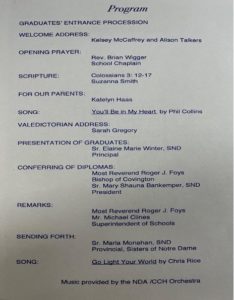
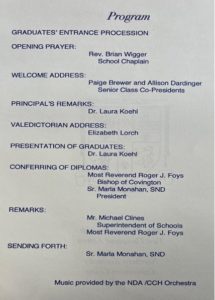
(2010 commencement program) (2011 commencement program)
GRADUATION ACTIVITIES
During the many decades at the 5th Street campus and then migrating to the Hilton campus, graduation was never a singular event. Specific activities leading up to the graduation ceremonies at Notre Dame included class day celebrations, a celebratory Mass and breakfast, an alumnae tea and class pictures. From articles found in the May issues of The Gavel, one can easily see how these activities paved the way for some of our most iconic graduation traditions, many of which are still practiced today.
CLASS DAY CELEBRATIONS
During the 1920s and 30s, the actual graduation day was preceded by a celebration of the seniors during the annual class day. The entire student body would gather at Mother of God Church for Mass and then walk back to school and gather for breakfast in the school auditorium. Afterwards, representatives from each of the grade levels entertained the seniors with skits, songs and poems.
“On Monday June 11, Class day will be celebrated at Notre Dame. Mass, Communion and Sermon will be followed by breakfast in the auditorium during which the graduates will be entertained by the undergrads. The seniors will conclude the program featuring their Class Prophecy, History, Poem and the Last Will and Testament of the Class of 1928.” (The Gavel, June 1928). During this part of the program, many of the seniors took the opportunity to “bequeath” school related items to members of the junior class. These class day activities provided a platform through which the entire student body could honor and celebrate the memories and accomplishments of the senior class, very similar to our current Senior Send-off activities. Currently, the day before senior exams begin, the entire school body gathers to recognize and celebrate the achievements of the soon to be graduates. Usual activities involve class level skits, dances and videos remembering activities and special times between that class and the seniors. Even the faculty get involved by presenting a special skit or song with music supplied by the “faculty band”. The day’s activities end with a slide show featuring pictures submitted by each senior to mark the conclusion of their time at NDA , after which they are invited to walk the halls one last time, cheered on by the student body.


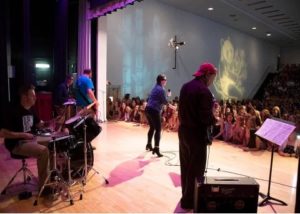
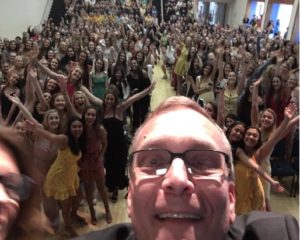
(Senior Sendoff pictures from 2014 and 2019)
GRADUATION DRESS
The earliest records of commencement ceremonies from Notre Dame Academy,
note the underclasswomen were required to wear their school uniforms and honor capes for the ceremony, and the junior class wore formal organdie gowns in either their class colors or a variety of pastel shades as they led the graduates into the auditorium. The graduates wore formal white dresses, white heels and carried a bouquet of roses and baby breath. The design of the graduation gown was usually left to the individual student, but there were several years when the entire class selected a dress which would be the same for all graduates. “The class of 1928 recently selected their graduation dress. The outfit is white crepe de chine, modeled along simple sport lines, with long sleeves. The bodice consists of an interesting design of diagonal pin tucking, cleverly spaced. The skirt is plain except for one kick pleat in the center front. The dress eliminates every vestige of fussiness.”
(The Gavel April 10, 1928)
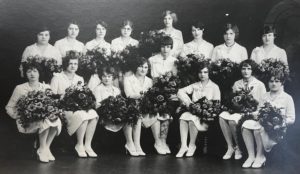
(NDA 1928 Scientific Graduates)
From 1913*-1925, formal pictures of the graduates were taken and printed in the summer issues of The Gavel. Even though these class pictures were separated into Commercial School and High School, they both featured a group photo of the graduates, dressed in their graduation dresses and holding their bouquets of roses.
(*as there are no existing pictures of graduates before 1913, this tradition can only be verified from this date)

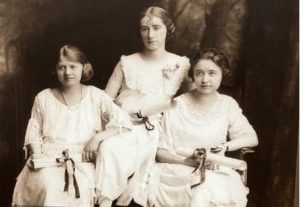
(1924 Commercial Graduates) (1922 High School Graduates)
A major change in the graduation dress was established in 1937, when the graduates, still carrying their bouquets of roses, donned white academic robes and mortarboards instead of individual white dresses.
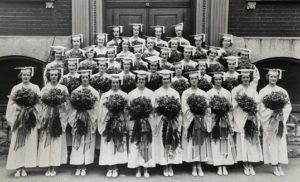
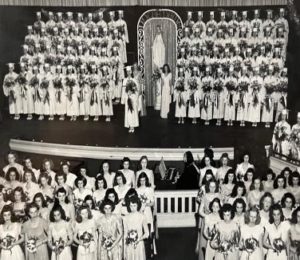
While the freshmen and sophomores continued to wear their honor capes and caps, in 1954 the junior escorts for graduation exchanged their own pastel colored gowns for ice blue academic robes and mortarboards. This tradition of white academic robes and red roses for the graduates and blue academic robes and yellow roses for the junior escorts still remains today.

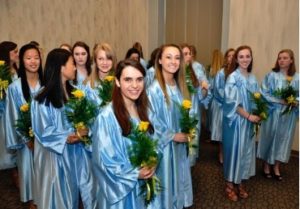
(Graduates and their escorts from 2014)
SENIOR PICTURES
Between 1926 and 1934, while the high school group picture remained the same, individual pictures of the high school graduates were taken wearing their school uniforms, and sometimes with their honor capes and caps. The graduation pictures for the commercial graduates changed from a group photo to individual pictures wearing their school uniforms and presented as a composite group picture. During the 1960’s individual pictures of all graduates were taken during the summer, prior to the start of senior year. Each year the class would decide if they would wear a nice outfit of their choosing or their white commencement gown and mortarboard for their individual pictures which were then published as a composite picture of the graduates. As of 2001, each senior now wears a black shoulder drape for their individual picture, which are then placed in a composite picture for the class.
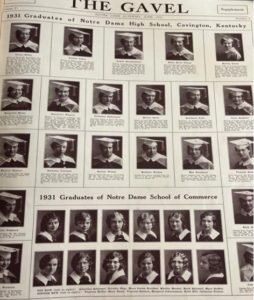

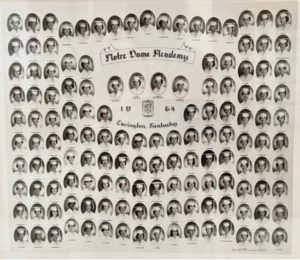
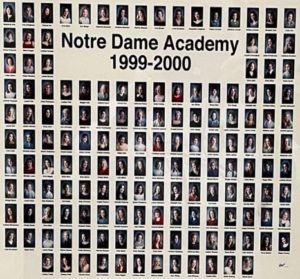

ALUMNAE LUNCHEONS
From the earliest of dates, on the day after graduation, all graduates gathered at St. Joseph Heights for a formal afternoon tea hosted by the Alumnae Society. During the program, which included entertainment by the junior class, each graduate was inducted into the Notre Dame Academy alumnae organization. During the late 1930s, this event turned into a luncheon held at The Heights or on campus, during which they were invited to join the NDA Alumnae Association. Today each senior is still invited to an Alumnae Luncheon held at the school, which features an introduction to the Alumnae Association and an address by a former alum who speaks on the value of an NDA education.
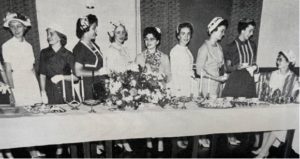
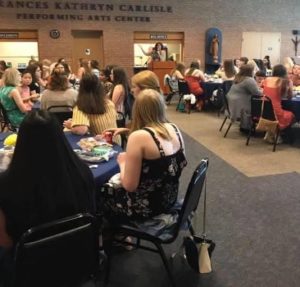
(1959 Alumnae Tea) (2019 Alumnae Luncheon)
Lastly, during the days leading up to graduation, the seniors joined together for their last school Mass, usually followed by a recognition breakfast, during which individual awards and recognition of college scholarships were celebrated. The breakfast evolved over the years including just the seniors, the seniors and their mothers, and then finally, as is celebrated today, the seniors and their parents or guardians.

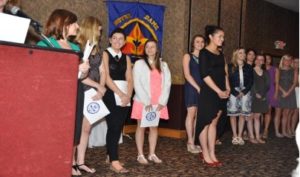

(pictures from the 2013 senior awards breakfast)
As you can see, from the earliest history of Notre Dame Academy, the protocols for commencement established by Sr. Mary Agnetis and her administration staff
would be used for the celebration of graduates, ending with the dignified and formal ceremony that our seniors today embrace as their last activity at NDA.
Graduates and their parents/guardians join together at the Baccalaureate Mass, to celebrate their faith, acknowledging the inspiration and guidance of the Virgin Mary, along with the support and encouragement received by the Sisters of Notre Dame. A celebratory breakfast is held for seniors and their parents/ guardians where academic awards, individual achievements and recognition of colleges, universities and further study opportunities are announced. And finally, the faculty and administration of NDA gather with the seniors and their families for the formal commencement ceremony. (below: Commencement Ceremony, May, 2024)
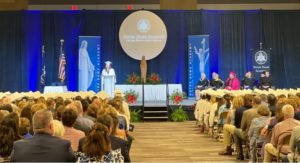
Today that ceremony is almost always held on the Friday before the Memorial Day holiday, in the late afternoon. Faculty and staff dressed in academic robes and collars designating their advanced degrees begin the ceremony with a procession into the hall. The seniors are escorted into the hall by underclass siblings of graduates, wearing the traditional ice-blue academic gown and carrying yellow roses. The graduates wear their white academic robes and caps with the white NDA tassel, each carrying their bouquet of red roses and baby breath, just as the very first graduates of the Academy did back in the early 1900s.
After each graduate is called to the podium to receive her diploma from the Bishop and congratulations from the President of NDA, a representative from the Sisters of Notre Dame ends the ceremony with a blessing and a challenge to each graduate to live her life in accordance to and with the beliefs of St. Julie Billiart.




